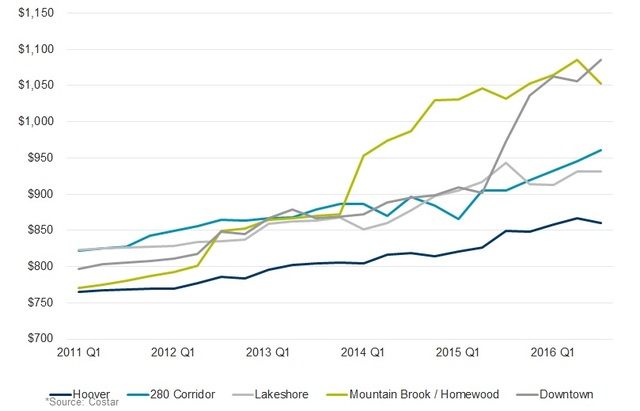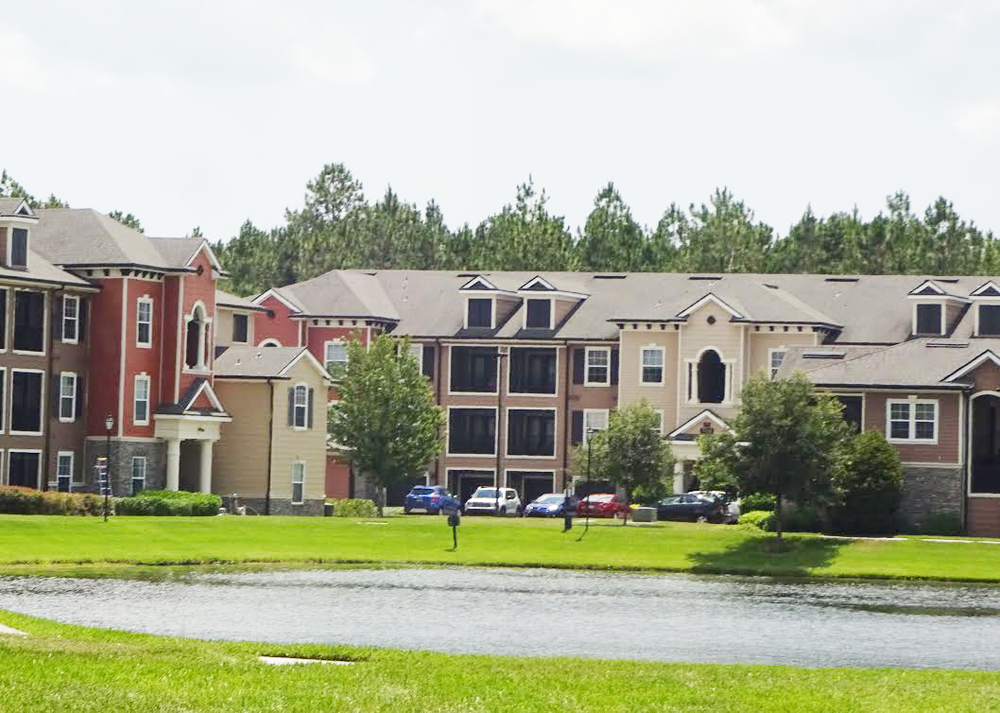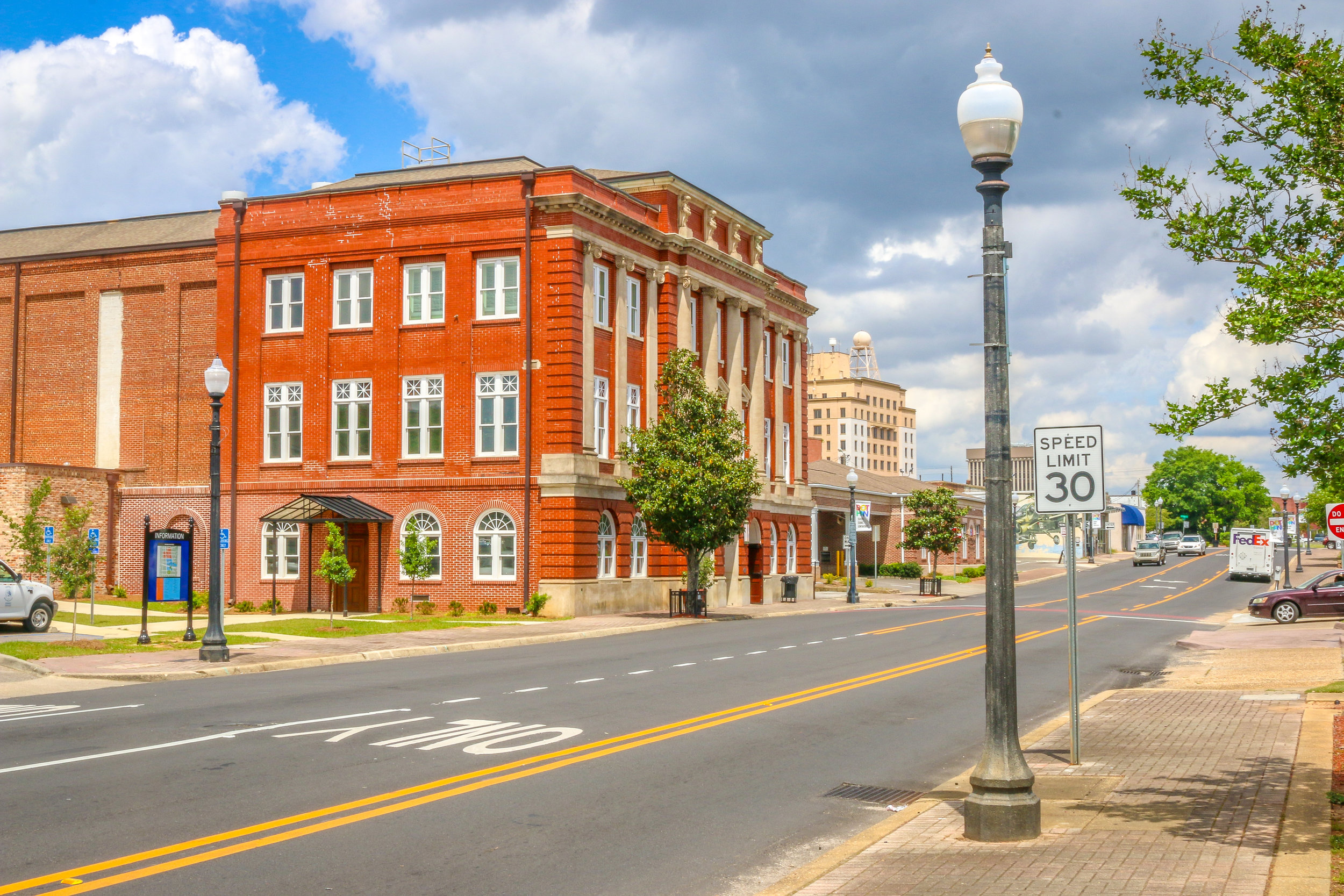Rent prices in Alabama’s major markets were on the rise in 2016.
According to experts from Cushman & Wakefield and Sealy Management Co., rent across some of Alabama’s largest markets rose throughout last year.
The chart below was provided by Cushman & Wakefield’s Jimmy Adams, and shows the submarkets of the Birmingham area and their average rent prices for the first three Quarters of 2016. Cushman & Wakefield utilizes some data from CoStar Group.
| Quarter | Hoover | 280 Corridor | Lakeshore | Mountain Brook / Homewood | Downtown | Birmingham |
| 2015 Q4 | $848 | $919 | $914 | $1,053 | $1,036 | $838 |
| 2016 Q1 | $858 | $932 | $913 | $1,065 | $1,062 | $843 |
| 2016 Q2 | $867 | $945 | $931 | $1,086 | $1,056 | $865 |
| 2016 Q3 | $860 | $961 | $931 | $1,053 | $1,086 | $864 |
Also these areas have seen rent increases over the past five years.

According to Adams, rent prices increased from the First Quarter of 2011 to the First Quarter of 2016. Here is a chart showing each area’s progress.
“Regarding rent prices, we are seeing year-over-year increases in rent levels across Alabama, according to Axio and CoStar,” said Adams, Executive Managing Director of Cushman & Wakefield’s Multifamily Advisory Group. “Although rent prices are increasing, rent growth may be decelerating as of [the Fourth Quarter] of 2016.”
Adams isn’t the only one who is seeing price increases in Alabama.
Tuscaloosa-based Sealy Management Co. owns and operates apartments in Tuscaloosa, Huntsville, Birmingham and Mobile.
“We were able to raise rent in all of those markets,” said Patrick Kennedy, president of Sealy Management.
After the housing crash and the recession took effect in 2008, lending standards for homebuyers got tighter, leaving homeownership out of reach for some, but as those regulations loosen, the rate is expected to rise from a historically low rate.
Millions of Americans are opting to rent, rather than buy, despite some progress that has been made in terms of lighter lending standards.
Also Americans choose to rent despite the increasing rent prices.
Kennedy said that renting is a short term commitment, compared to buying a home on a 30-year mortgage. Also, some people want to live in a particular area temporarily, such as a certain school zone.
The Millennial Effect
The Millennial population is expected to be a major player in the housing market in the year ahead, but many are still choosing to rent, whether it be financial reasons or lifestyle preferences.
Kennedy said many Millennials still prefer to rent because they want to be near the urban core, with access to stores, restaurants and other retail options.
He has also seen first-hand the demand for apartments from the growing student population at the University of Alabama in Tuscaloosa.
Millennials in larger metros enjoy the walkable lifestyle apartment living brings.
“Millennials are attracted to apartment renting over home ownership. . . [because of] a change in personal priorities compared to earlier generations,” Adams said. Two of these priorities are marriage and traveling. “People are getting married and having children at a later age than prior generations. Secondly, a traveling mentality or having the freedom to move appears to be a priority.”
Many Millennials are also strapped with student loan debt, Adams said.
“[T]he average student debt has doubled compared to 2003. . . [which postpones buying a home],” he said; and since millennials are in the early stages of their career, they aren’t ready to pay a mortgage or pay to maintain a home. Therefore, renting is a benefit because “monetarily the rent justifies not having a mortgage and all that comes with it.”
The Nation’s Average Rent Price for 2016
According to Abodo’s Annual Rent Report, the average rent price in America has gone up and down throughout 2016. According to National Rent Trends, the average price in January was $949 for a one bedroom apartment, which was .83 percent drop from December 2015.
In February the price was $955; the average price in March was $975, and April’s was $ 1,005. Then in May the price fell to $940, a .38% decrease; for June the price rose slightly to $945 and fell to $915 in August, a 1.48% decrease. September’s price was $1,052, the highest it has been in 2016. Despite the fluctuation, “the average renter in 2016 paid $1,001 per month” for a one bedroom apartment according to Abodo.
States with the Highest Rent Increase
Rhode Island had the highest increase of 7.1%, which made their average price for a one bedroom apartment $1,186. Connecticut ranked second with a 6.9% increase and an average price $1,042. Minnesota ranked third with an increase of 5.6% with an average price of $1,079. Washington D.C. had the highest average price of $1,999, but not the highest percentage change for price increase. Furthermore, Massachusetts ranked third highest with $ 1,898 for a one bedroom apartment; and California’s average price was $1,667 and New York’s was $1,630.
Rent Increase and Decrease by City and Region
The report shows the cities with the highest percentage change. Columbus, GA had the highest change “. . . at over 5%.” According to Abodo this is double their normal increase of 2.5%. Philadelphia comes in second with a monthly increase of 4.2%. Overall, most cities in the South, Southwest and Midwest experienced higher increases. Moreover, some cities exceed their state’s average rent price. According to the report, “Raleigh, NC [increased] (3.8%); Winston-Salem, NC (3.1%); Scottsdale, AZ (3.7%); and El Paso, TX (2.7%). . . .” These cities “more than triple their state average rates of rent increase.”
Here is a list of the top four cities that had the largest rent increase and their average price for a one bedroom apartment in January 2016.
- Columbus, GA (5.5%)—– $536
- Philadelphia, PA (4.2%)—– $1,182
- Raleigh, NC (3.8%)—– $1,121
- Long Beach, CA (3.8%)—– $1,418
Cities that experienced the largest rent decrease were west of the United States, excluding Newark, NJ. Below is a list of the top four cities with the largest decrease and their average rent price for January 2016.
- Oakland, CA (-4.1%) —– $3,240
- Newark, NJ (-3.8%) —– $2,737
- Las Vegas, NV(-1.8%)—– $881
- Tulsa, OK (-1.5%)—– $723
Top Four Cities with the Highest Rent Increase for January 2017
- Baton Rouge, LA (8.6%)—– $942
- Reno, NV (5.4%)—– $784
- San Antonio, TX (3.4%)—–$863
- Charlotte, NC (3.0%)—–$1,146
Top Four Cities with the Lowest Rent Decrease for January 2017
- El Paso, TX (-11.6%)—– $709
- Cincinnati, OH (-9.8%)—–$900
- Buffalo, NY (-8.7%)—– $965
- Scottsdale, AZ (-7.7%)—– $ 1,163
See the full report for more details.





